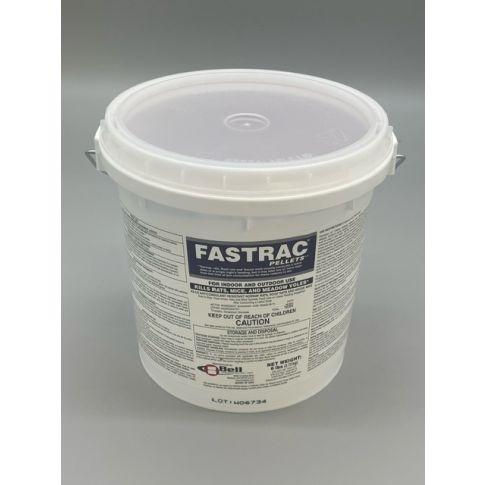Be the first to review this product
FASTRAC PELLET 6# PAIL
Fastrac Pellets is an acute, fast-acting rodenticide containing the active ingredient, Bromethalin, killing rats and mice in 2 or more days after consuming a toxic dose. Labeled for burrow baiting beyond 100' of man-made structures, FASTRAC Pellets is a great option for PMPs looking for additional baiting flexibility.
This pelleted bait is manufactured using an advanced formulation to produce a fresh tasting, durable pellet, noted for outstanding palatability and long shelf life. The hardness of the pellet also satisfies the rodent's desire to gnaw.Due to a quick knockdown when compared to anticoagulants, more rodents can be controlled with less bait.
| Size | 6# PAIL |
| Case Qty | 2 / CASE |
| Manufacturer | BELL LABS [view products, website] |
| EPA# | 12455-137 |
| Active Ingredient | Bromethalin |
| Label | belfp2006_fastrac_pellet_label_06122019.pdf |
| SDS | belfp2006_fastrac_pellet_sds_06122019.pdf |
| Target Pests | House Mice, Norway Rats, Roof Rats |
| Use | Residential, commercial, or industrial buildings, indoors and outdoors. |
| Application | All rodenticide baits should be placed in a Bell Labs tamper-resistant bait station. |
| No Web orders to | AK, CA, HI, PR, NON U S LOCATIONS |
| Coverage Area | All bait placements must be inside or within 50 feet of buildings. |
DIRECTIONS FOR USE:
This can only be used to control Norway rats, roof rats and house mice in and within 100 feet of man-made structures constructed in a manner so as to be vulnerable to commensal rodent invasions and/or to harboring or attracting rodent infestations. Examples of such structures include homes food processing facilities, industrial and commercial buildings, transport vehicles (ships, trains, aircraft), docks and port of terminal buildings and related structures around and associated with these sites.
Fence and perimeter baiting, beyond 100 feet from a structure as defined above, is prohibited.
This may be applied to active rodent burrows to control Norway rats, and roof rats within or beyond 100 feet of buildings and man-made structures, provided that infestations of these rodents have been confirmed. Bait must be placed no less than 6 inches into active Norway/roof rat burrows. Do not broadcast bait. Because Norway/roof rat infestations may occur in areas farther than 100 feet from buildings and man-made structures when the rodents have ample supplies of food and cover, efforts should be made to remove food trash, garbage, clutter and debris.
APPLICATION DIRECTIONS:
RAT CONTROL:
Apply 1 to 6 ounces of bait per placement (usually at intervals of 15 to 30 feet). Adjust the amount of bait applied to the level of rat feeding expected at each bait placement.MOUSE CONTROL:
BURROW BAITING:
For treating burrows, use a long-handled spoon to place ½ to 1 ounce of bait deep into each active burrow entrance. Close burrows with soil 3 to 7 days after bait placement. Retreat burrow entrances that are reopened by rats. If the area where treated burrows are located is accessible to children and nontarget animals, check burrows every morning and evening to make sure that bait has not been pushed out of burrows. Remove and properly dispose of any bait that has become accessible to children or nontarget animals.Highest bait consumption is expected to occur on the first day or two after treatment begins. After several days, inspect the placement and replenish bait at sites where there is evidence of heavy feeding or where there is continued evidence of rodent activity. Normally, the volume of bait consumed will be significantly less with bromethalin baits than with anticoagulant baits. Although one night’s feeding will usually provide a lethal dose, maintain bait for at least one week to provide all rodents a chance to feed on the bait. Continue baiting until all signs of feeding have ceased.
Refer to the Product Label for additional baiting instructions and approved application sites.
DIRECTIONS FOR USE:
This can only be used to control Norway rats, roof rats and house mice in and within 100 feet of man-made structures constructed in a manner so as to be vulnerable to commensal rodent invasions and/or to harboring or attracting rodent infestations. Examples of such structures include homes food processing facilities, industrial and commercial buildings, transport vehicles (ships, trains, aircraft), docks and port of terminal buildings and related structures around and associated with these sites.
Fence and perimeter baiting, beyond 100 feet from a structure as defined above, is prohibited.
This may be applied to active rodent burrows to control Norway rats, and roof rats within or beyond 100 feet of buildings and man-made structures, provided that infestations of these rodents have been confirmed. Bait must be placed no less than 6 inches into active Norway/roof rat burrows. Do not broadcast bait. Because Norway/roof rat infestations may occur in areas farther than 100 feet from buildings and man-made structures when the rodents have ample supplies of food and cover, efforts should be made to remove food trash, garbage, clutter and debris.
APPLICATION DIRECTIONS:
RAT CONTROL:
Apply 1 to 6 ounces of bait per placement (usually at intervals of 15 to 30 feet). Adjust the amount of bait applied to the level of rat feeding expected at each bait placement.MOUSE CONTROL:
BURROW BAITING:
For treating burrows, use a long-handled spoon to place ½ to 1 ounce of bait deep into each active burrow entrance. Close burrows with soil 3 to 7 days after bait placement. Retreat burrow entrances that are reopened by rats. If the area where treated burrows are located is accessible to children and nontarget animals, check burrows every morning and evening to make sure that bait has not been pushed out of burrows. Remove and properly dispose of any bait that has become accessible to children or nontarget animals.Highest bait consumption is expected to occur on the first day or two after treatment begins. After several days, inspect the placement and replenish bait at sites where there is evidence of heavy feeding or where there is continued evidence of rodent activity. Normally, the volume of bait consumed will be significantly less with bromethalin baits than with anticoagulant baits. Although one night’s feeding will usually provide a lethal dose, maintain bait for at least one week to provide all rodents a chance to feed on the bait. Continue baiting until all signs of feeding have ceased.
Refer to the Product Label for additional baiting instructions and approved application sites.

